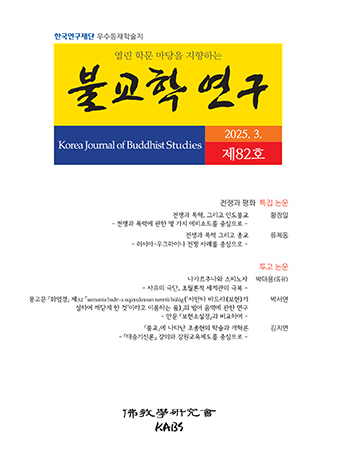특집논문
Abstract
References
Information
This study examines the inherent and structural factors that inevitably expose humans to violent situations, such as war, by analyzing several episodes from classical scriptures. First, it argues that the root causes of violence lie within the human condition itself, corrupted by the three poisons (三毒), as well as in the unavoidable karmic consequences of past actions. Next, it explores the social and structural origins of violence, showing how rulers—likened to venomous snakes—provoke wars to satisfy their thirst for power, thereby placing those under their authority inescapably at risk of war and violence. In response to these existential and structural constraints, the Buddha proposed renouncing worldly life and seeking nirvana within monastic communities like the Sangha as the most effective solution.
However, during the reign of King Asoka, the Sangha became entangled in royal authority, allowing kings to intervene even in internal monastic affairs. As a result, episodes seemingly endorsing violence arose in later Mahayana Buddhism, offering justification for participation in wars under the banner of “holy war.” Meanwhile, in Indian Buddhism, un-Buddhist behaviors such as war and violence were relegated to laypeople. This tendency appears to reflect a Sangha-centered worldview, in which renunciants, charged with preserving and disseminating the Dharma, grappled with the paradox of resorting to unwholesome means. This argument is further illustrated by the case of Sri Lanka, where monks were deemed justified, as a last resort, in temporarily reverting to lay status to engage in war under the rationale of a “holy war.”
However, during the reign of King Asoka, the Sangha became entangled in royal authority, allowing kings to intervene even in internal monastic affairs. As a result, episodes seemingly endorsing violence arose in later Mahayana Buddhism, offering justification for participation in wars under the banner of “holy war.” Meanwhile, in Indian Buddhism, un-Buddhist behaviors such as war and violence were relegated to laypeople. This tendency appears to reflect a Sangha-centered worldview, in which renunciants, charged with preserving and disseminating the Dharma, grappled with the paradox of resorting to unwholesome means. This argument is further illustrated by the case of Sri Lanka, where monks were deemed justified, as a last resort, in temporarily reverting to lay status to engage in war under the rationale of a “holy war.”
본 연구는 우리가 전쟁과 같은 폭력적 상황에 필연적으로 노출될 수밖에 없는 태생적, 구조적 문제를 가진 존재임을 경전(經典) 속의 몇 가지 에피소드를 중심으로 논구했다. 우선 폭력의 태생적 원인으로는 인간 존재 자체가 삼독(三毒)에 물들어 있으며, 과거 우리가 지은 과보(果報)의 결과로 필연적으로 발생할 수밖에 없음을 논구했다. 다음으로 폭력의 사회 구조적 원인으로는 독사(毒蛇) 같은 국왕이 자신의 권력욕을 채우기 위해서 전쟁을 일으키기 때문에 그 구조 속에 있는 한 전쟁과 폭력에 노출될 수밖에 없음을 논구했다. 이에 붓다는 이 태생적이고 구조적인 한계상황을 극복하기 위해서는 승가(僧伽)와 같은 성역(聖域)에 출가해서 열반을 추구하는 것이 최선의 길임을 제시했다. 하지만, 아쇼카(Asoka) 왕 때에 승가가 국왕의 세력권으로 들어가면서 국왕이 승가 내부의 문제까지도 결정하는 사태를 맞게 된다. 그 결과 후대 대승불교에서는 폭력을 옹호하는 듯한 에피소드들이 만들어짐으로써 성전(聖戰)이라는 이름으로 전쟁에 참전하는 빌미를 제공하게 되었다고 보았다.
한편, 인도불교에서는 전쟁이나 폭력과 같은 이런 비불교적인 행태들이 모두 재가자(在家者)의 몫으로 되었는데, 이는 아마도 승가 중심적 사고에서 비롯된 것으로 보았다. 즉 정법(正法)을 지키고 전파하는 출가자(出家者)가 폭력이라는 비법(非法)을 사용하는 이율배반적 상황을 고려했던 것으로 보인다. 이 주장은 스리랑카에서 성전을 위해서는 출가자가 한시적으로 환속해서 재가자 신분으로 전쟁에 참전할 수 있다는 고육지책이 이를 방증한다고 논구했다.
한편, 인도불교에서는 전쟁이나 폭력과 같은 이런 비불교적인 행태들이 모두 재가자(在家者)의 몫으로 되었는데, 이는 아마도 승가 중심적 사고에서 비롯된 것으로 보았다. 즉 정법(正法)을 지키고 전파하는 출가자(出家者)가 폭력이라는 비법(非法)을 사용하는 이율배반적 상황을 고려했던 것으로 보인다. 이 주장은 스리랑카에서 성전을 위해서는 출가자가 한시적으로 환속해서 재가자 신분으로 전쟁에 참전할 수 있다는 고육지책이 이를 방증한다고 논구했다.
- Dhp THE Dhammapada, The Pali Text Society, London, 1914.
- Vin Vinayapiṭaka vol Ⅲ, ed. by OLDENBERG, Hermann, Oxford: The Pali Text Society, 1997(reprinted, 1879).
- T Taishō shinshū daizōkyō 大正新脩大藏經, ed by TAKAKUS, Jujirō 高楠順次郞 and WATANABE Kaikyoku 渡邊海旭, 100 vols. Tokyo: Daizōkyōkai, 1924-1935.
- 『長阿含經』 T1
- 『雜阿含經』 T99
- 『增一阿含經』 T125
- 『勝鬘經』 T353
- 『大般涅槃經』 T374
- 『根本說一切有部毘奈耶』 T1442
- 『大智度論』 T1509
- ARMSTRONG, Karen 카렌 암스트롱, JEONG yeong-mog 정영목, tr. 2021. 『신의 전쟁 –성스러운 폭력의 역사』 (
Fields of Blood: Religion and the History of Violence ), Seoul: Gyoyangin 교양인. - GALTUNG, Johan 요한 갈퉁, et al. KANG, jong-il 강종일 and JEONG, dae-hwa 정대화, tr. 2000. 『평화적 수단에 의한 평화』 (
Peace by Peaceful Means ), Seoul: Deulnyeok 들녘. - HAJIME, Nakamura 中村元, CHA Cha-Seok 차차석, tr. 1993. 『불교정치 사회학』, Seoul: Bulgyosidaesa 불교시대사.
- HAJIME, Nakamura 中村元, SEOK Hye-neung 석혜능, tr. 2003. 『원시불교의 연구』, Seoul: Minjoksa 민족사.
- HAJIME, Sakurabe 櫻部建 and UEYAMA, Shunpei 上山春平, Jeong Ho-young, tr. 1994. 『아비달마의 哲學』, Seoul: Minjoksa 민족사.
- KIM, Hansang 김한상. 2015. 「스리랑카 불교 영웅 둣타가마니 왕의 무용담에 대한 문헌학적 접근- 테라와다 불교에서 성전은 용인되는가? -」 (“A Philological Approach to the Saga of Sinhalese Buddhist Hero Duṭṭhagāmaṇī -Is the Crusade justified in Theravāda Buddhism?-”), 『선문화연구』 (
Studies of seon culture ) vol. 19, 43-79. - KIM, Hoseong 김호성. 2003. 「‘정의의 전쟁’論은 정의로운가 –힌두교와 불교의 논의를 중심으로-」 (“Is the Theory of Righteous War Right?”), 『동서철학연구』 (
Studies in Philosophy East-West ), vol. 28, 5-35. - KIM, Youngjin 김영진. 2010. 「식민지 조선의 황도불교와 공(空)의 정치학」 (“The Imperial- Way Buddhism and the Politics of Emptiness in Colonial Korea”), 『한국학연구』 (
Institute of Korean Studies ), vol. 22, 49-74. - LAMOTTE, Étienne 에띠엔 라모뜨, Ho-JIn 호진, tr. 2006. 『인도불교사1』 (
History of Indian Buddhism ), Seoul: Sigongsa 시공사. - MOON, Eulsik 문을식. 2004. 「불살생에 관한 불교의 이상과 현실」, 『불교평론』 (
The Buddhist Review ) vol. 18. - PARK, Kyoungjoon 박경준. 2006. 「재가자는 출가자에 비해 하열한가」, 『불교평론』 (
The Buddhist Review ), vol. 27. - WON, Yongsang 원영상. 2014. 「불교와 전쟁-정토진종 전시교학의 구조분석을 중심으로-」, 제23회 국제불교문화학술회의 : 불교와 사회(2014. 10. 31. 원광대학교 숭산기념 관).
- YOSHIRO, Tamura 田村蒡郞, LEE Won-seop 이원섭, tr. 1993. 『열반경의 세계』, Seoul: Hyeonamsa 현암사.
- YUN, Jonggab 윤종갑. 2-11. 「불교와 정치권력 -정교분리에 관한 붓다의 관점을 중심으로-」 (“仏教と政治権力- 政教分離に関する仏陀の観点を中心に-”), 『동아시아불교문화』 (
Journal of eastern-asia buddhism and culture ), vol. 8, 249-287.
◆ 약호 및 일차 문헌 Abbreviations and Primary Sources
◆ 이차 문헌 Secondary Literature
- Publisher :Korean Association of Buddhist Studies
- Publisher(Ko) :불교학연구회
- Journal Title :Korean Journal of Buddhist Studies
- Journal Title(Ko) :불교학연구
- Volume : 82
- Pages :1∼23
- DOI :https://doi.org/10.21482/jbs.82..202503.1



 Korean Journal of Buddhist Studies
Korean Journal of Buddhist Studies






